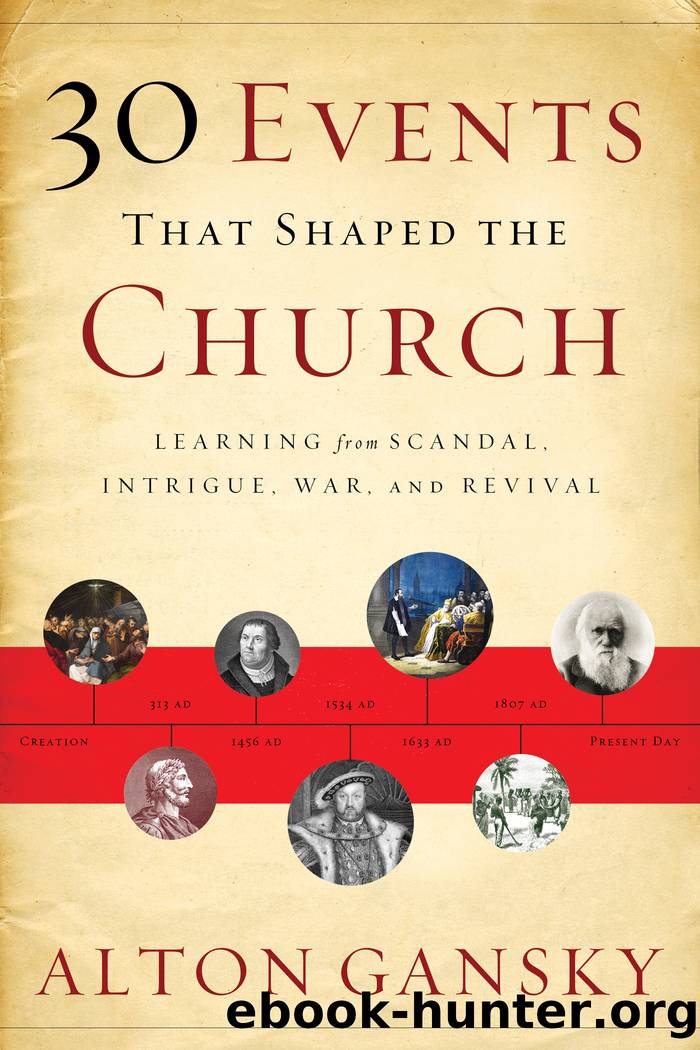30 Events That Shaped the Church by Alton Gansky

Author:Alton Gansky [Gansky, Alton]
Language: eng
Format: epub
Tags: Christian Living/Church History, Church history—Miscellanea, REL015000
ISBN: 9781441222343
Publisher: Baker Publishing Group
Published: 2018-03-22T00:00:00+00:00
16
Smyth Baptizes Himself and Begins the Early Baptists
(1609)
The church has changed much since its founding nearly two thousand years ago. Still, several things have remained the same. One lingering problem is the churchâs ability to subdivide itself, to fragment from the whole. This began in the first-century church with the rise of Judaizers who wanted all Christians to first be Jews, and with the Gnostics who wanted nothing more than to redefine the nature of Christ and set themselves up as the only trustees of knowledge. Even in established churches, divisions began within decades of a congregationâs establishment. Paul had to face such fragmentation in the church at Corinth.
Now I exhort you, brethren, by the name of our Lord Jesus Christ, that you all agree and that there be no divisions among you, but that you be made complete in the same mind and in the same judgment. For I have been informed concerning you, my brethren, by Chloeâs people, that there are quarrels among you. Now I mean this, that each one of you is saying, âI am of Paul,â and âI of Apollos,â and âI of Cephas,â and âI of Christ.â Has Christ been divided? Paul was not crucified for you, was he? Or were you baptized in the name of Paul? (1 Cor. 1:10â15)
Seeing division in the church deeply wounded Paul. Such divisions became a pattern, and the partings were often bitter, including exile and even, in some historical periods of the church, violence and execution. Some hold that division led to denominations and might be beneficial to the overall mission of the church, with Presbyterians reaching people Methodists canât, Methodists reaching those Baptists canât, and so on. This is true, but the fragmentation often came at great sacrifice and pain, and it would take centuries for the various branches of the church to learn to live together.
The birth of what most consider the largest âProtestantâ denomination, Baptist, came with pains delivered from without and within. Protestant is in quotes because some Baptist groups do not see themselves as part of the Protestant Reformation but rather a continuation of Baptist-like groups reaching back to the first century. Others hold to a different tradition. Baptist history has been a sore spot in some of the denominations. There are three lines of thought regarding the history of the Baptists.
First is Landmarkism, a belief that there exists an unbroken link to the days of the apostles. The view came to light in the mid-1800s in the American South. When the Southern Baptist Convention passed several resolutions against the idea, adherents split from the SBC to form their own conventions and churches.
Second, the Anabaptist theory, a belief that the Anabaptist movement of the early sixteenth century served as the foundation for what would become the Baptist denomination. Early Baptists, however, while sharing much in common with Anabaptists, also had some differences.
The most accepted view is the English Separatist view. This approach has the best historical evidence, a history that has its beginning in 1609 in a restless minister named John Smyth.
Download
This site does not store any files on its server. We only index and link to content provided by other sites. Please contact the content providers to delete copyright contents if any and email us, we'll remove relevant links or contents immediately.
Professional Troublemaker by Luvvie Ajayi Jones(28964)
Empire of the Sikhs by Patwant Singh(22172)
Twilight of the Idols With the Antichrist and Ecce Homo by Friedrich Nietzsche(17705)
Plagued by Fire by Paul Hendrickson(16636)
The Sun and Her Flowers by Rupi Kaur(13694)
Norse Mythology by Gaiman Neil(11883)
Adultolescence by Gabbie Hanna(8145)
A Journey Through Charms and Defence Against the Dark Arts (Harry Potter: A Journey Throughâ¦) by Pottermore Publishing(7939)
Fangirl by Rainbow Rowell(7833)
Wonder by R.J. Palacio(7732)
How to Bang a Billionaire by Alexis Hall(7411)
Crystal Healing for Women by Mariah K. Lyons(7376)
Becoming Supernatural by Dr. Joe Dispenza(7105)
Wonder by R. J. Palacio(7059)
Tools of Titans by Timothy Ferriss(6946)
The Road Less Traveled by M. Scott Peck(6634)
The Witchcraft of Salem Village by Shirley Jackson(6584)
The Lost Art of Listening by Michael P. Nichols(6472)
The Institute by Stephen King(6257)
